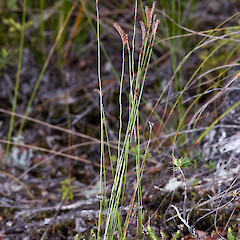Microschizaea fistulosa
Common name
comb fern
Synonyms
Acrostichum fistulosum (Labill.) Poir.; Schizaea fistulosa Labill.
Family
Schizaeaceae
Flora category
Vascular – Native
Endemic taxon
No
Endemic genus
No
Endemic family
No
Structural class
Ferns
NVS code
The National Vegetation Survey (NVS) Databank is a physical archive and electronic databank containing records of over 94,000 vegetation survey plots - including data from over 19,000 permanent plots. NVS maintains a standard set of species code abbreviations that correspond to standard scientific plant names from the Ngä Tipu o Aotearoa - New Zealand Plants database.
SCHFIS
Chromosome number
2n = 380, 540
Current conservation status
The conservation status of all known New Zealand vascular plant taxa at the rank of species and below were reassessed in 2017 using the New Zealand Threat Classification System (NZTCS) – more information about this can be found on the NZTCS website. This report includes a statistical summary and brief notes on changes since 2012 and replaces all previous NZTCS lists for vascular plants.
Please note, threat classifications are often suggested by authors when publications fall between NZTCS assessment periods – an interim threat classification status has not been assessed by the NZTCS panel.
- Conservation status of New Zealand indigenous vascular plants, 2017 . 2018. Peter J. de Lange, Jeremy R. Rolfe, John W. Barkla, Shannel P. Courtney, Paul D. Champion, Leon R. Perrie, Sarah M. Beadel, Kerry A. Ford, Ilse Breitwieser, Ines Schönberger, Rowan Hindmarsh-Walls, Peter B. Heenan and Kate Ladley. Department of Conservation. Source: NZTCS and licensed by DOC for reuse under the Creative Commons Attribution 4.0 International licence.
2017 | Not Threatened
Previous conservation statuses
2012 | Not Threatened
2009 | Not Threatened
2004 | Not Threatened
Distribution
Indigenous. New Zealand: Manawatāwhi / Three Kings Islands, North Island (widespread from North Cape south to about Waikato thence scarce), South Island (confined to North-west Nelson), Chatham Islands. Also present in Australia, Malaysia, Indonesia, New Guinea, New Caledonia, Fiji and Samoa.
Habitat
Coastal to lowland on clay pans, podzols, in gumland scrub, open scrub or forest, kauri forest (and then especially along ridged lines) and also in restiad peat bogs in Waikato and the Chatham Islands.
Wetland plant indicator status rating
Information derived from the revised national wetland plant list prepared to assist councils in delineating and monitoring wetlands (Clarkson et al., 2021 Manaaki Whenua – Landcare Research Contract Report LC3975 for Hawke’s Bay Regional Council). The national plant list categorises plants by the extent to which they are found in wetlands and not ‘drylands’. The indicator status ratings are OBL (obligate wetland), FACW (facultative wetland), FAC (facultative), FACU (facultative upland), and UPL (obligate upland). If you have suggestions for the Wetland Indicator Status Rating, please contact: [Enable JavaScript to view protected content]
FAC: Facultative
Commonly occurs as either a hydrophyte or non-hydrophyte (non-wetlands).
Detailed description
Rhizomatous, tufted fern. Rhizome short creeping, densely clothed with dark brown hairs. frond clustered, erect, undivided, 10–500 mm long, c. 0.5-1.0 mm wide, wiry, terete or subterete, furrowed on 1 side, green or pale brown with scattered hairs, smooth; sterile fronds similar to sporogenous fronds but much shorter; sporogenous heads 7–30 mm long, usually 5–12× longer than wide, narrowly triangular to linear-oblong, broadest at or near the base, tapering distally, straight or slightly curved; segments 2–5 mm long, smooth, glabrous or with sparse hairs. Sporangia not mixed with hairs. (Description adapted from Chinnock (1998) and Brownsey & Smith-Dodsworth (2000)).
Similar taxa
Morphologically similar to Microschizaea australis (which some botanists (e.g., Chinnock 1998, as Schizaea australis) had regarded as merely a reduced state of what is here called Microschizaea fistulosa). Microschizaea fistulosa differs from Microschizaea australis by its usually large size (stipe 100–500 cf. 20–150 mm mm long in M. australis), larger fertile sporogenous frond (7–30 mm cf. 4–15 mm in M. australis), slightly larger pinnae (1–5 mm cf. 1–4 mm long in M. australis), ecological preference for coastal and lowland habitats, and perhaps most convincingly by its different chromosome number (2n = 388, 540 cf. 2n = 188 in M. australis).
Microschizaea is genetically distinct from Schizaea s.s. though morphologically the chief difference is that Microschizaea fistulosa is said to have no hairs (i.e. glabrous) amongst the sporangia (Ke et al. 2022).
Flowering
Not applicable—spore producing
Flower colours
No flowers
Fruiting
Not applicable—spore producing
Propagation technique
Difficult—should not be removed from the wild
Etymology
fistulosa: From the Latin fistula ‘pipe’, referring to a cylindrical or terete shape which is closed at each end
Where To Buy
Not commercially available
Attribution
Fact sheet prepared for NZPCN by P.J. de Lange (14 March 2011). Description adapted from Chinnock (1998) and Brownsey & Smith-Dodsworth (2000).
References and further reading
Brownsey PJ, Smith-Dodsworth JC. 2000. New Zealand Ferns and Allied Plants. David Bateman, Auckland, NZ. 168 p.
Chinnock RJ. 1998. Schizaeaceae. Flora of Australia 48, Ferns Gymnosperms and allied groups: 177–187. ABRS/CSIRO Victoria, Australia.
Ke B-F, Wang G-J, Labiak PH, Rouhan G on behalf of the GoFlag Consortium; Chen C-W, Shepherd LD, Ohlsen DJ, Renner MAM, Karol KG, Li F-W, Kuo L-Y. 2022. Systematics and Plastome Evolution in Schizaeaceae. Frontiers in Plant Science 3: 885501. https://doi.org/10.3389/fpls.2022.885501.
NZPCN Fact Sheet citation
Please cite as: de Lange, P.J. (Year at time of access): Microschizaea fistulosa Fact Sheet (content continuously updated). New Zealand Plant Conservation Network. https://www.nzpcn.org.nz/flora/species/microschizaea-fistulosa/ (Date website was queried)








